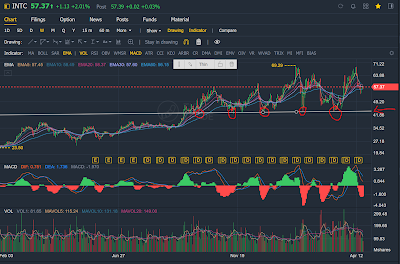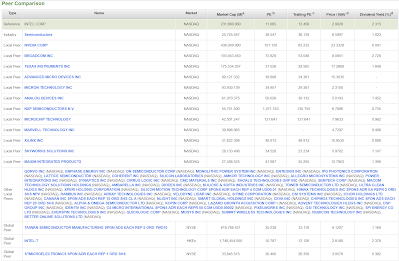In my previous article, I wrote a piece on AMD which looks like for the most part largely dominant in the competition of chips design in the CPUs space against Intel and GPUs against Nvidia.
One thing about investing in a growth company that you have to be comfortable at as an investor is the market will be pricing in premium expanded valuation to the company and at some point the growth will taper and that expanded valuation will have to come down quickly. Bluntly said, the market is pricing in a perfection and any risk that might deter the projected growth progress would send the company’s share price quickly downwards.
In this article, I’ll transform myself and take the opposite view and see Intel as a company from the angle of a contrarian value investor and see what’s left of value for Intel.
 |
| Source: Intel Infographics |
What are Intel’s biggest problems?
I think I covered this pretty thoroughly in my previous article on AMD but for those who’d like a summary – basically Intel’s biggest problem lies in its delayed development in its modern generation of chips which allowed companies like AMD to gain ground in the CPU market quickly.
While Intel’s 10NM CPUs are comparable to AMD’s 7NM CPUs, the nodes are measured differently and the latter offer similar performance with a much cheaper price. Intel is trying to catch up quickly by investing huge amount of capex into its foundry, hoping that they could close the gap with AMD in terms of its own 7NM chips but even at the earliest it will not be until 2023.
Meanwhile, latest news that came out in the last few days that AMD has proceeded and signed a 2 year contract with TSMC to manufacture its 3NM and 5NM chips for the next two years leading up to 2024.
In March 2021 earlier this year, Intel CEO – Pat Gelsinger announced the company’s new vision for “IDM 2.0”, a major evolution of the Integrated Device Manufacturing (IDM) model. This includes spending an approximately $20 billion investment to build two new factories in Arizona and aims to become a major provider of foundry capacity in the US and Europe.
While having its own foundry has its own benefits in terms of being able to control its own supply, it also means that they will have to spend huge amount of upfront capex to build these factories and manufacturing capabilities and this can erode the company’s margin while having to compete with the other foundries globally across the globe.
Where Does Intel’s Value Lies At?
So we already know (the market knows too) that Intel is facing all sorts of problem where it has to compete with the other foundries in terms of margins and manpower capabilities and AMD is also eating its bread and butter in the CPU and Data Center space.
Because of this, the market has priced in lots of negativity in the company’s valuation and today it is only trading at a PER of 12.4x, which is below the long term average of around 15x. In comparison, AMD is trading at a valuation of 34.5x (triple of Intel) and TSMC is trading at a valuation of 32.7x (almost triple of Intel).
In terms of FCF yield, Intel is still generating plenty of free cash flow with a yield of around 8.5% before they have to start spending on its growth capex on building the foundry to start manufacturing chips on its own.
As an investor, it might be worthwhile to look at Intel as a company from a bottom-up where you calculate your potential internal rate of return from your investment and the worst case scenario where most of the thesis surrounding the semi-conductor play doesn’t go according to plan.
First, Intel is currently trading at an earnings yield of 8.1% and FCF yield of 8.5% and it also pays a dividend of around $1.39/share which translates into a 2.42% yield for the investor. The company has also guided for a $10.5 billion FCF for the full year ended 2021.
In comparison, AMD is trading at an earnings yield of 2.9% and FCF yield of 1.8%. AMD also does not pay dividends to investor.
Second, and this is probably big and will be quite significant to movement on its earnings, is the announcement of the $10 billion accelerated buyback program which it announced late last year. While CEO Pat has played down some of the buybacks in recent weeks since the announcement of the $20b capex investment in building its own foundry, it is a program which has been approved by the Board and can be done given that Intel has generated so much FCF in recent years.
In other words, assuming Intel divide this buyback equally across 4 years, the company would spend a sum of $2.5b each year which will be approximately 10% of the FCF they are generating.
Third, the entire global IoT industry is screaming an increasing demand of chips while there is a huge lag of supply in today’s context which gives an opportunity to companies like Intel to catch up and continue to grow, despite losing market share to AMD.
What this means is that while AMD can continue to grow at 40-50%, Intel is likely to see a modest growth of between 5-10% over the next few years which is very decent for a company with their enticing valuation as compared to their peers.
Combining all the three metrics together – with dividends of around 2.4%, EPS growth of 3% through buyback and organic growth of around 5-10% would mean that it will still make a decent investment for an investor.
Let me explain here what I mean by that.
Putting it into Numbers
Intel has traditionally spend a maintenance and growth capex of between $13-$14b, which resulted in the FCF in the past two years of around $20b. The company has guided for a $20b investment for its own foundry in 2021 which means FCF is likely to half to around $10.5 billion which the company has already guided in its Q1 earnings call. This is an anomaly one-off spent which is likely to resume to normal from 2022 onwards. I have projected for a conservative 5-8% growth thereafter.
The company spent $2.6 billion in share buyback program last year and if we divide this number by the number of shares outstanding, it will add around $0.63 to the organic earnings per share.
In other words, just by doing buyback, Intel can actually “grow” its earnings per share by around 10% each year. Assuming the exit PE multiple remains equal, this means it is a 10% internal rate of return to an investor.
On top of this, investors get to enjoy a 2.4% dividend each year which should also be taken into consideration.
Last but not least, assuming the company still continue to grow at between 5-8% per year due to the overall sector boom, the company’s intrinsic value will be at around $63, which if we take across a 3 year CAGR, it is around 3.5% return per year.
If we add up the entire thing, an investor could well end up with a “10% + 2.4% + 3.5% return” each year from investing in Intel. Whether that is good enough it is subjective for each individual.
 |
| Source: 3F Working Compilation |
 |
| Source: Tiger Brokers |
 |
| Source: Shareinvestor Web Pro (Peer Comparison) |


Great article and agree with you that growth stocks are more risky as you will never know when the growth would taper down due to unforeseen circumstances.
Also with regards to eps growth by share buybacks you stated:
"In other words, just by doing buyback, Intel can actually "grow" its earnings per share by around 10% each year"
Correct me if im wrong but with 2.5bil USD per yr buybacks for 4 yrs (10bil USD total), the EPS growth would only be 1/(1-(2.5/230))-1 which is abt 1.1% EPS growth due to share buybacks.
Assuming 2.4% div and 5-8% organic EPS growth, total return should be around 8.5%-11.5% which is still decent. This is for a share price of 57usd. Like you said i think 45usd will be a good entry point as there is strong support.
Appreciate your thoughts on this!
Hi Sennett
I may get this wrong myself but may I ask how do you get the 230 from the equation of 1/(1-(2.5/230))? My calculation is that with 2.5b in today's context of 4.1b outstanding shares, that would equate at about 0.60 eps which translate to about 10+% in today's context of its EPS of 5.3 cents/share.
4.04bil shares outstanding × 57usd share price to get around 230bil market cap. 2.5bil USD share buybacks would purchase 43.86mil shares at 57USD. Reducing the shares outstanding by 1.09%. Thus using the formula of EPS/(1-0.0109) you will obtain the eps after share buyback of a factor 1.011x the original eps
Or put it in another way, with 20bil usd earnings this translates to 4.95USD eps at 4.04bil shares outstanding. After subtracting 43.86mil shares after the buyback, 3.996bil shares outstanding remain. 20bil/3.996bil = 5.01 USD EPS which is arnd 1.1% higher than the previous eps of 4.95
Of course this assumes the valuation multiple stays the same at arnd 11-12 P/E, if it does revalue upwards to its avg of 15 it does provide some additional upside potential of 32% above the stated 8.5-11.5% total returns. At 45usd, the additional upside would increase to 66%, i.e total return of 3% div + 76-81% (EPS growth × revaluation factor)
Hi Sennett
Yeah good point, though I suspect Intel as a laggard the market is unlikely to revalue upwards on the multiples (unlike companies like say Nvidia which has that obvious valuation expansion). My guess is it will remain "cheap" for as long as it continues to lose market share but investors will still yield decent return from this investment over time for as long as the chips thesis are still intact.
We Give out personal loans for debt consolidation, bad credit loans, unsecured loans, loans for bad credit and instant secured loans with cheap rates Do you have a firm or company that need loan to startup a business or need, personal loan, Debt consolidation? For more information. We will provide you with loan to meet your needs. For more information contact Note: And many More:and many more at 2%interest rate; (Whats App) number: +919394133968 [email protected] Mr Jeffery